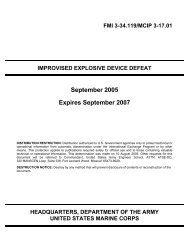FM 4-0, Sustainment - GlobalSecurity.org
FM 4-0, Sustainment - GlobalSecurity.org
FM 4-0, Sustainment - GlobalSecurity.org
- No tags were found...
Create successful ePaper yourself
Turn your PDF publications into a flip-book with our unique Google optimized e-Paper software.
Chapter 2well as tailored to interface with the theater logistics structures. For further information on ARSOFlogistics capabilities refer to <strong>FM</strong> 3-05.140.BRIGADE SUPPORT BATTALION (BSB)2-86. BSBs are <strong>org</strong>anic components of BCT, Fires, and Maneuver Enhancement Brigades. The BSB istailored to support the particular brigade to which it is <strong>org</strong>anic. For example, the BSB of a heavy brigadecombat team (HBCT) has more fuel distribution capabilities and maintenance than does a fires brigadeBSB. The battalion provides supply, maintenance, motor transport, and medical support to the supportedbrigade. The BSB plans, prepares, and executes, logistics operations in support of brigade operations.AVIATION SUPPORT BATTALION (ASB)2-87. The ASB is the primary aviation logistics <strong>org</strong>anization <strong>org</strong>anic to combat aviation brigade (CAB)and the theater aviation brigade. The ASB performs the BSB mission. Combat aviation brigades typicallyconduct attack, reconnaissance, security, movement to contact, air assault, air movement, aero medicalevacuation, personnel recovery, and C2 support missions. It provides aviation and ground fieldmaintenance, brigade-wide satellite signal support, replenishment of all supplies, and medical support tothe aviation brigade. The ASB has been optimized to support the CAB’s forward support companies,aviation maintenance companies, and the brigade HQ and HQ company (see <strong>FM</strong> 4-90.23).INTERAGENCY COORDINATION2-88. Interagency coordination is the coordination that occurs between elements of Department ofDefense and engaged U.S. Government agencies for the purpose of achieving an objective (<strong>FM</strong> 3-0). It isan essential characteristic of unified action. Military operations must be coordinated with the activities ofother agencies of the United States government, IGO, NGO, and activities of various HN agencies.2-89. The SECDEF may determine that it is in the national interest to task U.S. military forces withmissions that bring them into close contact with (if not in support of) IGOs and NGOs. In suchcircumstances, it is mutually beneficial to closely coordinate the activities of all participants. Unity ofeffort between IGOs, NGOs, and military forces should be the goal. Taskings to support IGOs and NGOsare normally for a short-term purpose due to extraordinary events. In most situations, sustainment,communications, mobility, and security are the capabilities most needed.2-90. For some operations, sustainment forces may be employed in quantities disproportionate to theirnormal military roles and in nonstandard tasks. Furthermore, they may precede other military forces ormay be the only forces deployed. They also may have continuing responsibility after the departure ofcombat forces in support of MNFs, OGAs, IGOs, or NGOs. In such cases, they must adhere to anyapplicable status-of-forces agreements (SOFA) and acquisition cross service agreements (ACSAs) towhich the United States is a party.2-91. In a national emergency or complex contingency operation, DOD and the U.S. military often servein a supporting role to other agencies and <strong>org</strong>anizations. Commanders and their staffs should develop anunderstanding of how military operations and capabilities can be coordinated with those of other agenciesand <strong>org</strong>anizations to focus and optimize the military’s contributions to accomplish the desired end state.US agencies, the UN, IGOs, NGOs, and MNFs provide for their own sustainment. However, US militarysustainment capabilities are frequently requested and provided to these <strong>org</strong>anizations. The JTF may beasked to assume all or part of the burden of logistics for these <strong>org</strong>anizations after arrival. This supportmay include intertheater and intratheater airlift, ground transportation of personnel, equipment, andsupplies, airfield control groups, and port and railhead operations groups.MULTINATIONAL SUSTAINMENT OPERATIONS2-92. A major objective when Army forces participate in the sustainment of multinational deploymentsis to maximize operational effectiveness. Support provided and received in multinational operations must2-14 <strong>FM</strong> 4-0 30 April 2009

















